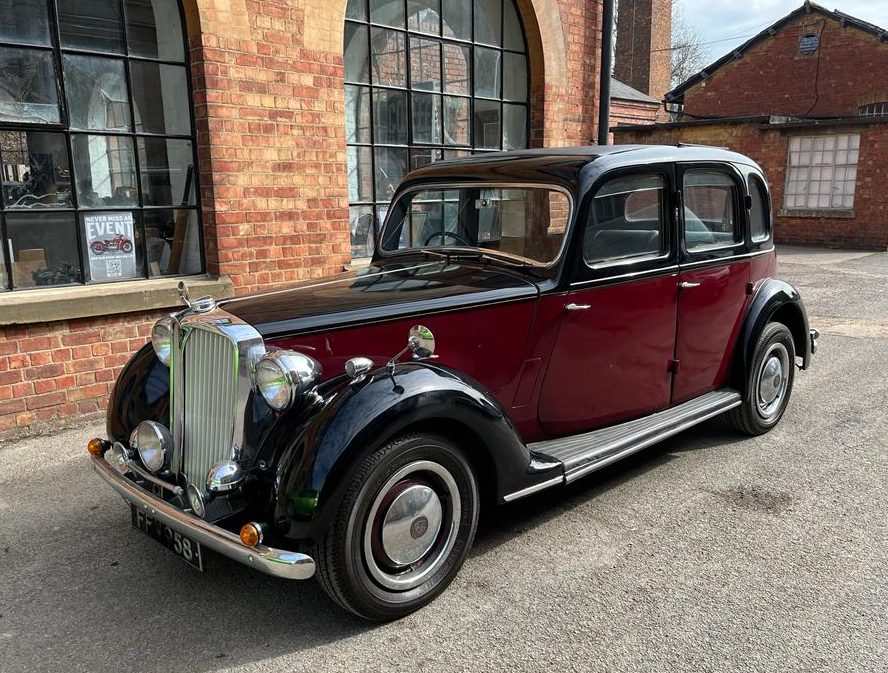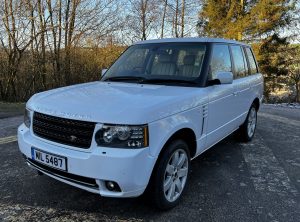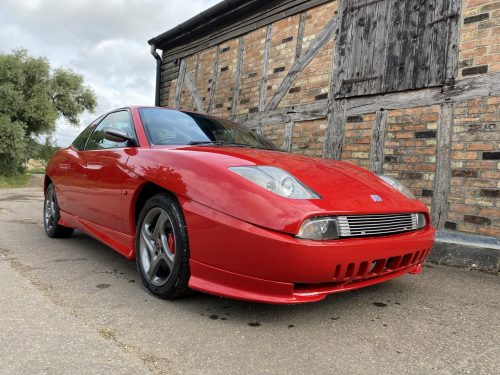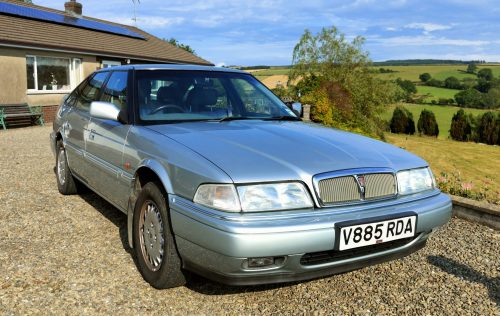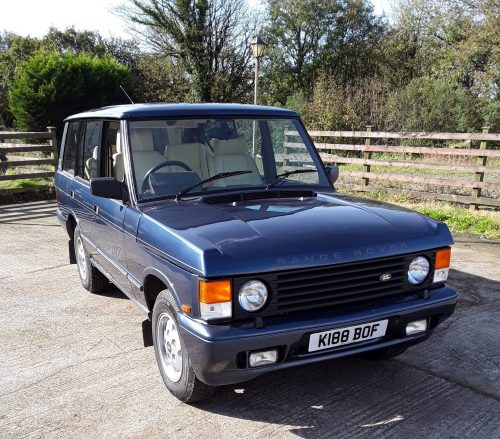- 2.1 litre straight-six engine
- Regency Maroon
- Black wings
- Original grey leather upholstery
- Many original features
| MAKE | Rover |
| MODEL | 75 P3 Saloon |
| REGISTRATION | FFW 958 |
| ENGINE SIZE | 2103 |
| TRANSMISSION | Manual |
| CURRENT V5 | |
| COLOUR | Red & Black |
| LOCATION | Northampton, Northants NN7 |
1949 Rover 75 P3 Saloon *Sold £9,000*
In stock
Description
- 2.1 litre straight-six engine
- Regency Maroon
- Black wings
- Original grey leather upholstery
- Many original features
“One of Britain’s Finest Cars—Now Made Finer” is how the Rover brochure described the post-war classic Rover P3 75. They were right too. These Rovers were only made for two years. That makes them rather scarce today and, in this condition, very desirable.
History
- Original buff logbook from 1949
- MOTs dating back 40 years
Outside
The Rover P3 75 (the P standing for post-war) designed by Gordon Bashford was an entirely new Rover. It had the quality of Rover’s recent past, though the 75 was half an inch wider outside than the 16 it replaced, it was 2.5 inches wider inside. The Rover 75 could be bought in tall roof, “six-light” (three windows per side) Saloon, or Sports Saloon body styles.
All doors were rear hinged “coach doors” (or suicide doors). Remarkably for the time the Rover was produced in five colours— black, green, grey, maroon, and “Sundown” each with specific contrasting interior colours.
This Rover P3 75 is the so-called ‘Six-Light Saloon’. The Black and Red paintwork suits the big Rover. All the chrome is in good order, bear in mind that this car was built in 1949 though. It comes with lovely period features. Take a look around the car; those superb headlights, running boards, semaphores and those hubcaps – how have they survived. It is unusual to see one in this condition.
Inside
Jumping inside reminds you of a stately home that is growing old peacefully without the intervention of English Heritage making it ‘better’. It is all rather charming.
Features we just do not see on modern cars such as the armchair like armrests in the rear are all still there. Up front it is the same. The wood instrument panel and full instrumentation were part and parcel of the era. The original three thin spoke steering wheel remains. Ventilation improvements promised 100 cubic feet of air per minute. Or you could just open the huge windows, your choice.
It is a septuagenarian now so don’t be expecting a new car. But the great thing is it still looks original, well, as original as something can be after this length of time. Best of all it hasn’t been messed about with, therefore retains the old car feel.
Mechanicals
The whole of Britain faced enormous challenges in 1949. None more so than manufacturing industries. Rover took a bold step to innovate with the Rover P3.
The 1948-49 P3 Rover line was vastly simplified. The engines were the singular four and six-cylinder lines respectively dubbed 60 and 75 after approximating real horsepower ratings.
The engines were a clean-sheet post-war design, featuring several modern features:
- Inclined cylinder head
- Intake valves in the cylinder head
- Exhaust valves in the block itself
- A side mounted double-roller-chain-driven camshaft.
- This required crossflow intake and exhaust manifolds
- The upmarket six-cylinder engine like this one, used a two-barrel down-draught carburetor
- Light metal alloys were used in valve covers, timing covers, and the oil pan
This 2.1 litre straight-six makes 72 hp at 4,000 rpm. Rover designed a nearly hemispherical combustion chamber, with the spark plug located in the centre.
The engine is mated to a floor shifted four-speed manual with synchromesh on third and fourth gears, plus a freewheeling function to allow clutchless shifting on the move.
We’re told “This Rover drives just as she should with a strong engine and a quiet gearbox and is ready to be enjoyed by her new owner”.
This Rover P3 75 has other innovations that would be carried over into the modern-looking P4 75 of 1950.
- Independent coil spring front suspension with an anti-roll bar
- A semi-elliptical leaf spring rear
- The frame itself was all steel rather than the previous steel-over-ash construction Rover
- The rear leaf springs were attached directly to the body rather than the chassis.
- Hydraulic front brakes
All of this results in increased rear-axle travel and a smoother ride.
Summary
Autocar magazines tested a P3 on February 4, 1949:
“This satisfying car of the highest quality does everything with a silky smoothness, a soothing quietness, and also in about the highest degree of riding comfort in front and back seats yet known, and with a precision and lightness of control with makes a driver feel on top of his form and which renders every mile a delight whether in town or out on the open road…Throughout, there is that suggestion of top mechanical quality, exclusive to a tiny fraction of cars, which eludes detailed description.”
Praise indeed.
Good luck! Please remember, our site uses anti-sniping software which ensures fairness to all bidders. So, if a bid for a lot is received in the last minute, the auction will go into a 2-minute overtime period for each subsequent bid.
Vehicle Location: Northampton, Northants NN7 – it’s the responsibility of the winning bidder to make collection / transportation arrangements directly with the vendor.
Would like to arrange a viewing or have a question about this Rover 75? Please contact the Evoke team at auction@evoke-classics.com and we will speak to the vendor on your behalf.
Guide Prices?
We’re different. But you know that. And we’re always honest. In a sector where no two classics are same, how does anyone put a ‘guide’.
Well, everyone knows the broad value of classic, let’s all be honest. So we don’t need to tell you what you already know, do we.
The ‘market’ decides and the old cliché that ‘it’s worth what someone wants to pay’ is no less true. So why kid everyone!
But, because we are different, if it really does matter to you, that’s fine, we want you to be happy. Just drop us a line at auction@evoke-classics.com and one of us will be delighted to ring you back and discuss, it’s what we do.
Tedious but it’s vital you read this, please.
We will always strive to offer the most descriptive and transparent auction listings available. However, we can’t claim to be perfect. Your own analysis is very important and we are here to help and also answer any and all queries you may have prior to purchase.
We offer and positively encourage buyers to view, or arrange inspections for each vehicle thoroughly prior to bidding.
If we do take a physical, as opposed to a remote, look at any of the vehicles on our platform, they are not those of a qualified vehicle inspector or other professional. Nor do they include a test drive unless expressly stated.
As with all vehicles of a certain age, localised paint repairs are common. This specifically applies with classics.
So, please, unless we state explicitly to the contrary, please assume that classic vehicles on our platform could have had remedial bodywork of any kind at some point in its life.
Two final comments on images and photos.
The vast majority are supplied by vendors. Camera technology has and continues to improve significantly, but please note and understand that image and sound quality does vary. If you would like vendors to provide more images please ask us and we will contact the vendor for you.
If you are at all unsure, just ask us. It is what we are here for.
Finally, finally, finally. Please note that vehicles are sold as seen and a returns policy is not applicable. This is the norm for used items acquired at auction.
Our Terms and Conditions are here and our FAQS can be found here or contact us: auction@evoke-classics.com
Got one you’d like to sell? Please feel free to get in touch to have a no obligation chat with us:
